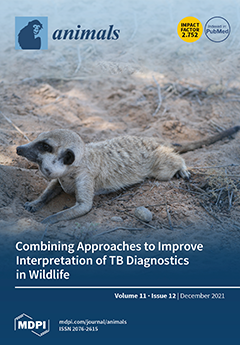The objective of this study was to compare the molecular, physiological and microbial effects of mushroom powder (MP), vitamin D
2 enriched mushroom powder (MPD
2) and zinc oxide (ZnO) in pigs post-weaning. Pigs (four pigs/pen; 12 pens/treatment) were assigned to: (1) basal diet (control), (2) basal diet + ZnO, (3) basal diet + MP (2 g/kg feed) and (4) basal diet + MPD
2 (2 g/kg feed). Zinc oxide supplementation improved the feed intake (
p < 0.001); increased the caecal abundance of
Lactobacillus (
p < 0.05); increased the villus height (
p < 0.05) in the duodenum, jejunum and ileum; increased the expression of chemokine interleukin 8 (
CXCL8;
p < 0.05); and decreased the expression of pro-inflammatory cytokine gene interleukin 6 (
IL6;
p < 0.05), tumour necrosis factor (
TNF;
p < 0.05), nutrient transporters peptide transporter 1 (
SLC15A1;
p < 0.05) and fatty acid binding protein 2 (
FABP2; (
p < 0.05) in the duodenum. Whereas dietary supplementation with MPD
2 improved the gastrointestinal morphology (
p < 0.05); increased the total volatile fatty acid concentrations (
p < 0.05); increased the expression of anti-inflammatory cytokine gene interleukin 10 (
IL10;
p < 0.05) and nutrient transporters
SLC15A1 (
p < 0.05),
FABP2 (
p < 0.05) and vitamin D receptor (
VDR;
p < 0.05); and reduced the expression of pro-inflammatory cytokine gene IL6 (
p < 0.05), it adversely affected average daily feed intake (ADFI;
p < 0.001) and average daily gain (ADG;
p < 0.05). Mushroom powder supplementation had a positive impact on gastrointestinal morphology (
p < 0.05) and upregulated the expression of nutrient transporters
SLC15A1 (
p < 0.05) and
FABP2 (
p < 0.05) and tight junction claudin 1 (
CLDN1) (
p < 0.05) compared to the controls but had no effect on the expression of inflammatory markers (
p > 0.05). Furthermore, MP reduced ADFI (
p < 0.01); however, this did not negatively impact the ADG (
p > 0.05). In conclusion, MP and MPD
2 have limited use as commercial feed additives in replacing ZnO in pig diets as feed intake was reduced post-weaning.
Full article






